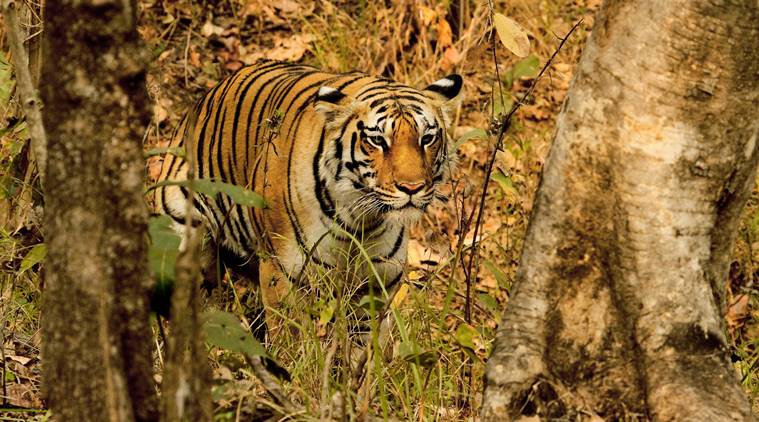
On International Tiger Day 2019 observed on July 29 annually, as the fresh tiger census report ‘Status of Tigers in India-2018’ pegs the number of tigers in India at 2,967 (up from 2,226 in the 2014 census), biologists and wildlife experts suggest the “robust rise” may only be “window dressing” the core issues that tiger conservation in India needs to tackle. One among them is the translocation of tigers, which deals with their being transported to tiger-deficient habitats as a way to balance the sex ratio or re-establish tiger presence.
Tiger conservationist Valmik Thapar concurs, “It has sort of become fashionable for officials to translocate the big cats without an understanding of the area or how a male tiger looks for a female tigress to mate in a new location and the problems that crop up. There are also concerns around ‘tranquiliser overdose’ as in the case of the T-75 male tiger, in June this year, in Sariska that was relocated from Ranthambhore Tiger Reserve in April 2019 to balance the sex ratio.”
Emphasising that a “detailed three-month study” of the habitat, human populations nearby, the prey-base and ecology is required before moving the tigers, Thapar told indianexpress.com that such projects are “fraught with risks”. “Forest officials are looking for immediate results in terms of population increase of tigers with no understanding of the area,” he said.
Some of the prominent examples that India witnessed over the past year include Madhya Pradesh’s Kanha National Park, which started relocating tigers as a part of India’s first-ever inter-state translocation project. But the tiger, named MB2, which was shifted to Satkosia Tiger Reserve in Odisha was eventually found dead within months of the Inter-State Tiger Translocation Project. The big cat was reported to have died of a maggot-infested wound and septicemia. Preceding him, on July 26, 2018, Tigress Sundari arrived at her new home in Satkosia from Madhya Pradesh’s Bandhavgarh Tiger Reserve as part of the project. But within three months of being translocated, she had to be tranquilised and put behind bars when she made killed two people and injured four.
Biologist Dr Ullas Karanth, terming the translocation a “needless distraction”, told indianexpress.com, “It harms local people and wastes money. If the natural prey base is built up through years of protection, tigers will naturally colonise most such areas — releasing captive-bred tigers which do not possess hunting skills, or even wild tigers — into prey deficient areas most often leads to man-eating problems. Yet officials and some biologists seeking glory do not seem to understand this simple fact, in spite of many examples.”
In India, such translocation projects are undertaken by the National Tiger Conservation Authority (NTCA), a body to manage and conserve tigers, under the Union Ministry of Environment, Forest and Climate Change (MoEF&CC). It is governed by the “Protocol for Tiger Re-introduction”.
Even though the protocol calls for a team of experts from the Wildlife Institute of India (WII), forest department of the state, a qualified veterinarian and wildlife biologist to evaluate the socio-economic impact of the translocation on the people in the area in a scientific way, experts suggest that “understanding of habitats in detail and of the nearby human settlement is first required”.
Remarked Dr Karanth, “With the resources used in almost two decades, the count should be 10,000 tigers at least.” He explained, “We had about 2,000 tigers in late 1960s and have less than 3,500 now. This is despite massively increased tiger reserve budgets and higher official positions related to tigers. The money is being spent excessively on less than 10 per cent of the potential tiger habitat of about 3,00,000 square kilometers. Moreover, much of the expenditure is on needless habitat manipulations, rather than on much-needed voluntary relocation of families and land purchases to consolidate habitats.”
India is home to 70 per cent of the world’s prowling cats, found in its dwindling forests, mangrove swamps and Himalayan foothills of the sub-continent. Previously, while the tiger census 2014 pegged the total number in the country at 2,226, the 2010 census put the figure at 1,706 and the 2006 version at 1,411, indicating that tiger numbers have been increasing continuously.
The other issues that plague the conservation efforts are the shrinking prey base of deer and pigs, and man-animal conflicts alongside poaching that continues unabated. The outcome is almost always dead tigers, which is what we’re seeing now in India and beyond.
So, is there a way out? The presence of tigers is an indicator of the well-being of ecosystem, as its forest lockup carbon provides a great adaptation to climate change effects. “We need to foster ownership of local people through an inclusive agenda beyond tiger source areas. This means engagement with local people, fostering more collaborative partnerships between government and non-government stakeholders,” remarked Thapar.
Dr Karanth summed up, “Let us have a vision of an India with 15,000 wild tigers, and a world with 50,000 tigers and work hard to meet that goal.”